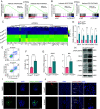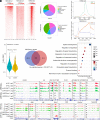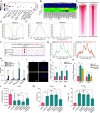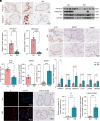Trophoblast PR-SET7 dysfunction induces viral mimicry response and necroptosis associated with recurrent miscarriage
- PMID: 37307441
- PMCID: PMC10288560
- DOI: 10.1073/pnas.2216206120
Trophoblast PR-SET7 dysfunction induces viral mimicry response and necroptosis associated with recurrent miscarriage
Abstract
Recurrent miscarriage (RM) is a distressing pregnancy complication. While the etiology of RM remains unclear, growing evidence has indicated the relevance of trophoblast impairment to the pathogenesis of RM. PR-SET7 is the sole enzyme catalyzing monomethylation of H4K20 (H4K20me1) and has been implicated in many pathophysiological processes. However, how PR-SET7 functions in trophoblasts and its relevance to RM remain unknown. Here, we found that trophoblast-specific loss of Pr-set7 in mice led to defective trophoblasts, resulting in early embryonic loss. Mechanistic analysis revealed that PR-SET7 deficiency in trophoblasts derepressed endogenous retroviruses (ERVs), leading to double-stranded RNA stress and subsequent viral mimicry, which drove overwhelming interferon response and necroptosis. Further examination discovered that H4K20me1 and H4K20me3 mediated the inhibition of cell-intrinsic expression of ERVs. Importantly, dysregulation of PR-SET7 expression and the corresponding aberrant epigenetic modifications were observed in the placentas of RM. Collectively, our results demonstrate that PR-SET7 acts as an epigenetic transcriptional modulator essential for repressing ERVs in trophoblasts, ensuring normal pregnancy and fetal survival, which sheds new light on potential epigenetic causes contributing to RM.
Keywords: ERVs; H4K20me1/3; PR-SET7; recurrent miscarriage; viral mimicry.
Conflict of interest statement
The authors declare no competing interest.
Figures








Similar articles
-
PR-SET7 epigenetically restrains uterine interferon response and cell death governing proper postnatal stromal development.Nat Commun. 2024 Jun 10;15(1):4920. doi: 10.1038/s41467-024-49342-6. Nat Commun. 2024. PMID: 38858353 Free PMC article.
-
Decidual macrophages derived NO downregulates PD-L1 in trophoblasts leading to decreased Treg cells in recurrent miscarriage.Front Immunol. 2023 Jul 14;14:1180154. doi: 10.3389/fimmu.2023.1180154. eCollection 2023. Front Immunol. 2023. PMID: 37520550 Free PMC article.
-
A dual role for the histone methyltransferase PR-SET7/SETD8 and histone H4 lysine 20 monomethylation in the local regulation of RNA polymerase II pausing.J Biol Chem. 2014 Mar 14;289(11):7425-37. doi: 10.1074/jbc.M113.520783. Epub 2014 Jan 23. J Biol Chem. 2014. PMID: 24459145 Free PMC article.
-
PR-Set7 and H4K20me1: at the crossroads of genome integrity, cell cycle, chromosome condensation, and transcription.Genes Dev. 2012 Feb 15;26(4):325-37. doi: 10.1101/gad.177444.111. Genes Dev. 2012. PMID: 22345514 Free PMC article. Review.
-
[The biological functions of lysine methyltransferase PR-SET7].Yi Chuan. 2013 Mar;35(3):241-54. doi: 10.3724/sp.j.1005.2013.00241. Yi Chuan. 2013. PMID: 23575530 Review. Chinese.
Cited by
-
Histone H4 lysine 20 monomethylation is not a mark of transcriptional silencers.bioRxiv [Preprint]. 2025 Jan 13:2025.01.09.632211. doi: 10.1101/2025.01.09.632211. bioRxiv. 2025. PMID: 39868205 Free PMC article. Preprint.
-
Basic Research Advances in China on Embryo Implantation, Placentation, and Parturition.Matern Fetal Med. 2024 Jan 15;6(1):37-49. doi: 10.1097/FM9.0000000000000210. eCollection 2024 Jan. Matern Fetal Med. 2024. PMID: 40406740 Free PMC article.
-
Necroptosis in recurrent implantation failure: A bioinformatics analysis of key genes and therapeutic targets.Medicine (Baltimore). 2024 Jul 26;103(30):e38907. doi: 10.1097/MD.0000000000038907. Medicine (Baltimore). 2024. PMID: 39058876 Free PMC article.
-
PR-SET7 epigenetically restrains uterine interferon response and cell death governing proper postnatal stromal development.Nat Commun. 2024 Jun 10;15(1):4920. doi: 10.1038/s41467-024-49342-6. Nat Commun. 2024. PMID: 38858353 Free PMC article.
-
Impact of air pollution exposure on cytokines and histone modification profiles at single-cell levels during pregnancy.Sci Adv. 2024 Nov 29;10(48):eadp5227. doi: 10.1126/sciadv.adp5227. Epub 2024 Nov 29. Sci Adv. 2024. PMID: 39612334 Free PMC article.
References
Publication types
MeSH terms
LinkOut - more resources
Full Text Sources
Molecular Biology Databases
Research Materials

